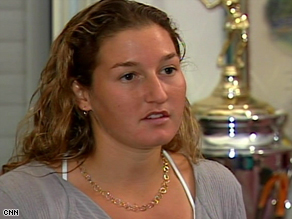
The U.S. Senate looks to be on track to pass a bill that sounds almost exactly like what President Barack Obama asked for last month. The measure — now heralded as $780 billion, down from $890 billion — will include about 40% in tax cuts and more than 80% of the spending will flood the faltering economy within the next 18 months. But with just three Republican votes, the bill falls well short of the bipartisan goal Obama worked hard to achieve.
The final cost of the bill remained fuzzy late Friday as Senators scrambled to figure out how three amendments the Senate has already passed, estimated to add at least another $30 billion more in spending, would affect the total. Ten additional pending amendments could also alter the overall number. Democrats estimate the total in the end could range from $780 billion to $820 billion; Republican leaders said they believe the bill would cost more than $827 billion even before other amendments are added.
Nevertheless, the deal has three GOP votes in the Senate in its support — three more than the President got in the House. They come at a cost. Depending on what the final bill amounts to, the deal could cost more than $35 billion in cuts per Republican vote. And that’s after the Dems removed several provisions at the G.O.P. senators’ request — from family planning for low-income women to money to restore the National Mall. Senator Susan Collins, the lead Republican negotiator said that minuscule support from her party proved how hard it will be for Obama to overcome deep political divisions. “It’s really unfortunate as I think the American people really want us to work together and really are sick and tired of all the partisanship,” she said.
At one time, the Obama Administration had hoped to draw as many as 80 votes in the Senate but several spending provisions that would not have kicked in until after 2011 drew fire from both sides of the aisle. Collins and Senator Ben Nelson, a Nebraska Democrat, spent most of the week closeted with 18 centrists, including six Republicans, hammering out the deal reached late Friday. In the end only Collins, her fellow Senator from Maine, Olympia Snowe, and Arlen Specter of Pennsylvania signed on. Collins said she will continue to lobby her GOP colleagues.
Since he took office Obama has reached out to the GOP, even though the Democrats hold large majorities in both chambers of Congress. The President made an unprecedented trip to the Hill to meet with the Republican conferences, invited select GOP Senators to meet him with him in the Oval Office, at times one-on-one, and called numerous senators to convince them to come on board. In recent days, though, as the bill languished before the Senate his tone turned sharper. “The American people did not choose more of the same,” Obama said at a White House meeting Friday announcing his Economic Recovery Advisory Board. “They did not send us to Washington to get stuck in partisan posturing, or to turn back to the same tried and failed approaches that were rejected in the last election. They sent us here with a mandate for change, and the expectation that we would act. The bill before Congress isn’t perfect, but it is absolutely necessary.”
Democrats had hoped to vote on the measure Friday. Indeed, Senator Ted Kennedy, who is undergoing treatment for a brain tumor, was prepared to return to Washington to cast his vote in support. But Republicans said they wanted more time to examine the deal and passage looks unlikely until Tuesday afternoon. “No action is not what any of my Republican colleagues are advocating, but most of us are deeply skeptical that this will work,” Senate minority leader Mitch McConnell said announcing his opposition to the measure. “And that level of skepticism leads us to believe that this course of action should not be chosen.” It remained unclear if Senator Judd Gregg, a New Hampshire Republican who is Obama’s nominee to run the Commerce Department, would vote. Gregg had said he did not intend to, but if Kennedy is absent he may be forced to step in to help pass his future boss’s plan.
Most of the cuts that led to the deal — about $85 billion — came from reduced spending on school construction , teacher funding and higher education. The negotiators also cut provisions that the Congressional Budget Office said diffused less than 10% of funds into the economy within 18 months — for example, shrinking Head Start and a program to make federal buildings more energy efficient. “The Democrats wanted to see a lot of education funding and the Republicans generally argued that the programs, while worthwhile, should go through the regular appropriations process,” Collins said. “Or in the case of the $19 billion for school construction there’s a real case on whether that’s a federal role or a local and state role.” Tax cuts and other finance provisions allowed the negotiators to slash another $25 billion.
White House chief of staff Rahm Emanuel attended the Democratic caucus’ briefing on the compromise and senators said he pushed hard for their support. Emanuel, a former House leader still popular with his ex-colleagues, may help win backing for the bill from House Dems upset over the loss of funding for their projects. Obama will also hit the road to sell the stimulus, visiting Elkhart, Ind., and Fort Myers, Fla., early next week. Elkhart has one of the highest unemployment rates in the country — at, 15.3%, dramatically up from 4.7% a year ago. Fort Myers has an unemployment rate of 10%.
Democratic leaders hope that the only thing Americans will remember of this excruciating process is the passage of a historic bill that could go a long way to fixing the economy. With his own twist to Lincoln’s Gettysburg Address, Illinois Senator Dick Durbin, the No. 2 Democrat in the Senate, said: “The world will little note nor long remember how many votes we had to pass the measure. The world and Congress and the nation want to know if this will work. If it passes with 61 votes or 81 votes, it’s just a footnote in history.”
See TIME’s pictures chronicling the history of the White House kitchen.
See pictures of presidential First Dogs.









